 Abraham Lincoln
If given the truth, the people can be depended upon to meet any national crisis...
Abraham Lincoln
If given the truth, the people can be depended upon to meet any national crisis...
 Guildford news...
for Guildford people, brought to you by Guildford reporters - Guildford's own news service
Guildford news...
for Guildford people, brought to you by Guildford reporters - Guildford's own news service
V1 Flying Bomb Attacks On Send and Ripley – Burnt Common Incident And Others
Published on: 30 May, 2022
Updated on: 30 May, 2022
By Frank Phillipson
A detailed follow up to John Glanfield’s recollections of the Burnt Common V1 incident published previously.
The V1 Flying Bomb attacks on Britain began on the June 13, 1944 when the population were still taking in the good news that the allies had landed in Normandy and there was some prospect that the war might be entering its final phase.
These V1 attacks launched from France continued until September 1 when launch sites were overrun by allied forces. During the same period commencing from July 9, V1’s were also air launched towards London from under the wing of Heinkel 111 bombers. Over 400 V1’s were launched by this method before the last were fired on September 5, after which the Luftwaffe were forced to retreat back to Germany.
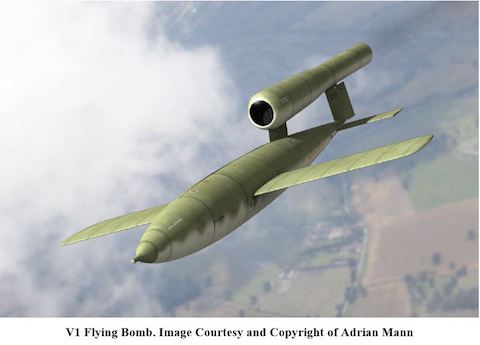 Unfortunately, on September 8 there commenced the V2 rocket attacks launched from Holland which continued until March 27, 1945. On September 16 , air launched V1 attacks recommenced with aircraft based in Holland and Germany. These continued until January 14, 1945. Finally, from March 3, 1945, longer range V1s with a reduced warhead, were ground launched from Holland and these ceased on March 28.
Unfortunately, on September 8 there commenced the V2 rocket attacks launched from Holland which continued until March 27, 1945. On September 16 , air launched V1 attacks recommenced with aircraft based in Holland and Germany. These continued until January 14, 1945. Finally, from March 3, 1945, longer range V1s with a reduced warhead, were ground launched from Holland and these ceased on March 28.
From early September, south-western Surrey was not greatly affected by the ongoing attacks compared with the first V1 campaign launched from France between June and September.
On Monday August 21, 1944, a V1 launched from France flew over the North Downs and continued in a northerly direction towards Burnt Common, Send. Just before 1.10pm when over Green Lane, West Clandon, its two explosive dive mechanisms fired which put the rudder and elevator into a neutral position and released two spoilers that dropped down from the underside of the tail plane.
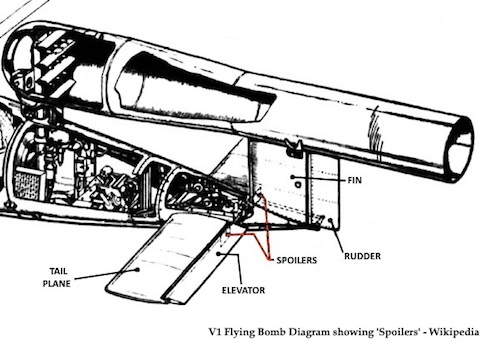 These put the bomb into a sudden dive with the abrupt negative ‘G’ force starving the engine of fuel leading to the characteristic silence as the engine cut out. It was at this point that schoolboy John Glanfield took cover in a ditch below.
These put the bomb into a sudden dive with the abrupt negative ‘G’ force starving the engine of fuel leading to the characteristic silence as the engine cut out. It was at this point that schoolboy John Glanfield took cover in a ditch below.
The bomb, with its almost one-ton warhead, struck 5 and 6 Burnt Common Council Houses completely demolishing the semi-detached properties and causing substantial damage to other surrounding houses. These government subsidised, council-built group of houses had been put up after the First World War and had been first occupied in May 1926.
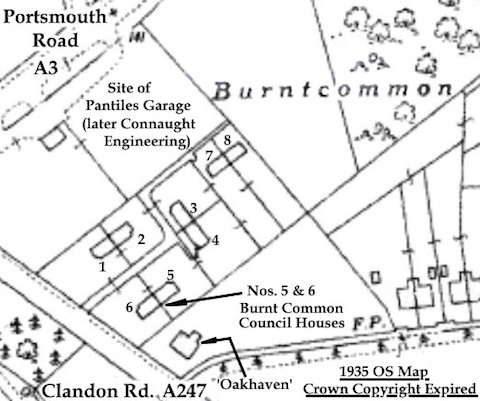 Local residents Sid Stanley and Harold Parrot had cycled along Portsmouth Road from Ripley and at (the then) Burnt Common crossroads were about to ride down Send Barns Lane when they heard the flying bomb. Before they could decide what to do, they were blown off of their bikes into a ditch. An elderly man who had also been thrown into the ditch had to be helped to get out.
Local residents Sid Stanley and Harold Parrot had cycled along Portsmouth Road from Ripley and at (the then) Burnt Common crossroads were about to ride down Send Barns Lane when they heard the flying bomb. Before they could decide what to do, they were blown off of their bikes into a ditch. An elderly man who had also been thrown into the ditch had to be helped to get out.
 All about there was a red mist caused by brick dust from the demolished building. An American convoy came along the road and stopped and wouldn’t let anybody cross the road to get near the site of the explosion.
All about there was a red mist caused by brick dust from the demolished building. An American convoy came along the road and stopped and wouldn’t let anybody cross the road to get near the site of the explosion.
Another local, Bob Whapshott, saw debris go up from the explosion with some chickens stuck in trees and numbers 5 and 6 Burnt Common Council Houses both with their sides gone.
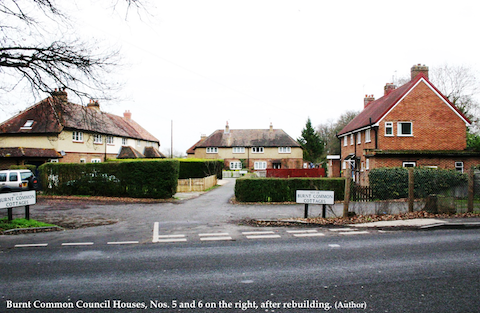 From his vantage point at Green Lane, John Glanfield watched as a large black column of smoke arose from behind trees where the V1 had landed. There was also the sound of much glass being shattered by the blast at Fogwills Burnt Common nurseries where many of the glasshouses were badly damaged together with much of the tomato crop within them.
From his vantage point at Green Lane, John Glanfield watched as a large black column of smoke arose from behind trees where the V1 had landed. There was also the sound of much glass being shattered by the blast at Fogwills Burnt Common nurseries where many of the glasshouses were badly damaged together with much of the tomato crop within them.
Four members of the Privett family were killed at 5 Burnt Common Council Houses. They were Howard Ernest Privett (52) and his wife Violetta Florence Privett (nee Bowers) (42), their daughters, Violetta Florence Bowers (born pre-marriage) (22) and May Joyce Privett (three and a half). They were buried in one large grave at Send Parish church.
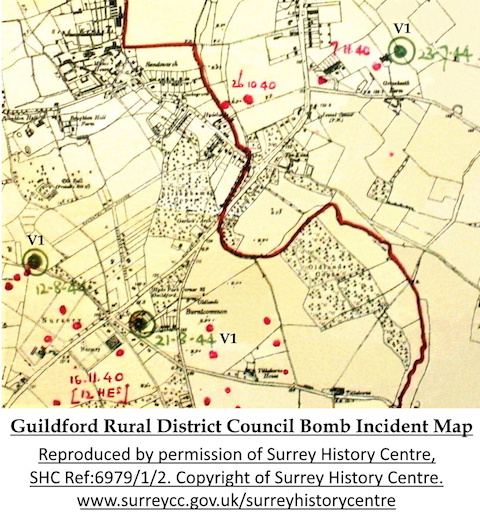 Howard was home for lunch from his work at the Crack Processing Mill in Tannery Lane, Send, which during the Second World War was processing natural raw materials such as gums, resins, dried foods, and plant materials for the war effort. Howard had served as a private throughout the First World War with the 13th and 19th Hussars.
Howard was home for lunch from his work at the Crack Processing Mill in Tannery Lane, Send, which during the Second World War was processing natural raw materials such as gums, resins, dried foods, and plant materials for the war effort. Howard had served as a private throughout the First World War with the 13th and 19th Hussars.
Daughter Violet was at home asleep as she was doing night work at Pantiles garage (just around the corner) repairing aircraft parts from Fairoaks airfield where Bristol Aeroplane Company had a repair facility.
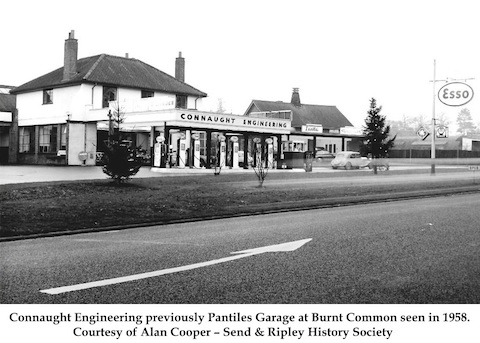 The Privett’s son Gilbert (15) was working as a trainee fitter at J. Gibbs, makers of agricultural machinery in Ripley. Gibbs, a business established in Bedfont, Middlesex, had set up their branch at Ripley in 1938 and it was located on the site of Ryde House School and is today the site of Ripley Co-Op.
The Privett’s son Gilbert (15) was working as a trainee fitter at J. Gibbs, makers of agricultural machinery in Ripley. Gibbs, a business established in Bedfont, Middlesex, had set up their branch at Ripley in 1938 and it was located on the site of Ryde House School and is today the site of Ripley Co-Op.
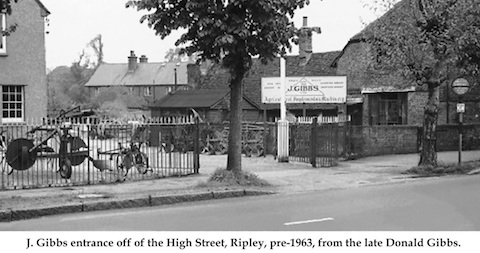 Gilbert was cycling home along the Portsmouth Road for lunch at 5 Burnt Common Council Houses and had just come to the (then) crossroads at Burnt Common. As he turned into Clandon Road towards his home, someone shouted “In the ditch” and he and this person jumped in the ditch. There was then a massive explosion and when the dust had settled his home number 5, together with number 6, had been completely demolished by the flying bomb with the other properties having broken windows and damage from blast.
Gilbert was cycling home along the Portsmouth Road for lunch at 5 Burnt Common Council Houses and had just come to the (then) crossroads at Burnt Common. As he turned into Clandon Road towards his home, someone shouted “In the ditch” and he and this person jumped in the ditch. There was then a massive explosion and when the dust had settled his home number 5, together with number 6, had been completely demolished by the flying bomb with the other properties having broken windows and damage from blast.
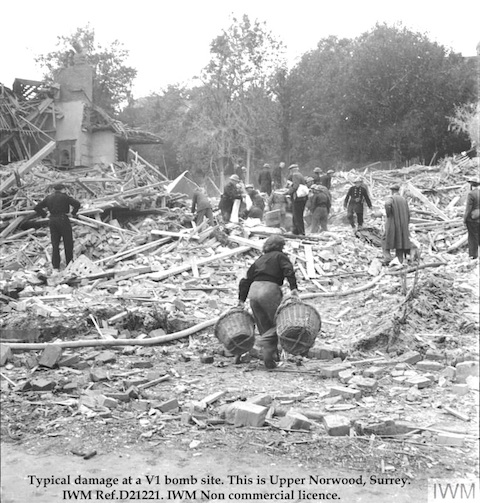
Desperately running to the remains of his home he climbed over the rubble frantically looking for his family. He had to be pulled away and led off by a member of the Civil Defence services.

Newspaper cutting from the Surrey Advertiser of August 26, 1944
Gilbert’s two younger brothers Gordon (10) and Derek (7) and sister Yvonne (8) were safe at the school where they were having lunch. Gilbert and his siblings then went to live with various relatives.
Next door at number 6, Alice Wright and her daughter Hilda were at home but managed to scramble under the indoor steel Morrison “table” shelter and survived. Of their possessions only a stone hot water bottle remained intact.
 On the West Clandon side of numbers 5 and 6 was a house called ‘Oakhaven’ where Horace and Dora Mellem lived with their lodger Charles Webber. Initially the house had remained standing but then collapsed with Dora and Charles inside. Although injured they both survived as they had been sitting on either side of a chimney breast.
On the West Clandon side of numbers 5 and 6 was a house called ‘Oakhaven’ where Horace and Dora Mellem lived with their lodger Charles Webber. Initially the house had remained standing but then collapsed with Dora and Charles inside. Although injured they both survived as they had been sitting on either side of a chimney breast.
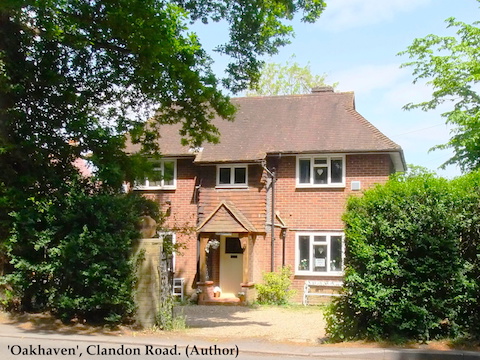 A V1 caused blast damage over a wide area as it exploded on the surface. A huge blast wave rippled out from the epicentre and as it did so it left a huge vacuum, which caused a second rush of air as the vacuum was filled. This caused a devastating pushing and pulling effect and could leave dead victims seemingly unmarked. The blast radius of a V1 could be 400 to 600 yards or more in each direction.
A V1 caused blast damage over a wide area as it exploded on the surface. A huge blast wave rippled out from the epicentre and as it did so it left a huge vacuum, which caused a second rush of air as the vacuum was filled. This caused a devastating pushing and pulling effect and could leave dead victims seemingly unmarked. The blast radius of a V1 could be 400 to 600 yards or more in each direction.
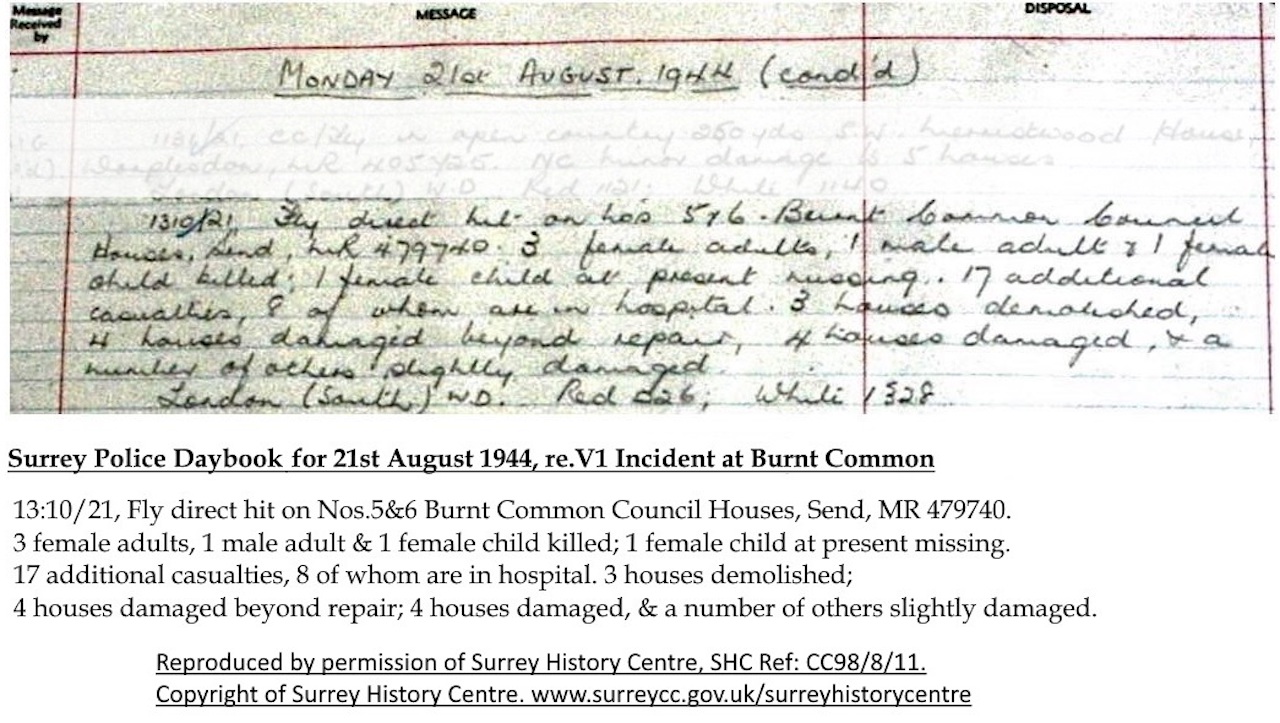 As well as those killed, three women, two men and a girl were injured and had to be detained in hospital; four women, three men and a girl and a boy were slightly injured. The blast caused damage to 44 properties. For the homeless, a rest centre was opened at West Clandon Village Hall.
As well as those killed, three women, two men and a girl were injured and had to be detained in hospital; four women, three men and a girl and a boy were slightly injured. The blast caused damage to 44 properties. For the homeless, a rest centre was opened at West Clandon Village Hall.
 A Civil Defence Heavy Rescue squad, usually based at the Surrey County Council depot at Merrow Sidings, were at The Sands near Farnham, possibly still dealing with a previous V1 incident a few days before when they were summoned to Burnt Common.
A Civil Defence Heavy Rescue squad, usually based at the Surrey County Council depot at Merrow Sidings, were at The Sands near Farnham, possibly still dealing with a previous V1 incident a few days before when they were summoned to Burnt Common.
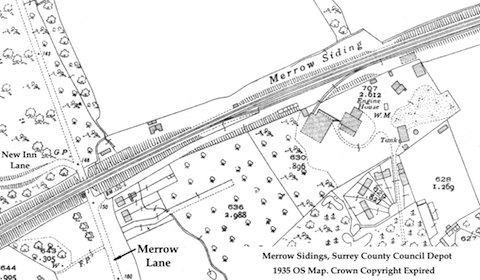 Their job at a bomb incident was to assess and then, after making them as safe as possible, access damaged buildings and rescue the injured or retrieve the dead.
Their job at a bomb incident was to assess and then, after making them as safe as possible, access damaged buildings and rescue the injured or retrieve the dead.
In addition, they would turn off gas, electricity and water supplies, and repair or pull-down unstable buildings.
Heavy Rescue Squads had specialist heavy lifting and digging equipment and were usually comprised of men from the building trades including a bricklayer, a plumber, an electrician and a group of general labourers, all of whom completed a first-aid course. Their vehicle would probably be a requisitioned lorry equipped with the lifting equipment, ladders, pumps and timber to shore up buildings.
 There were two teams of men in the Heavy Rescue squad at Merrow. Each were made up of eight men who worked 12-hour shifts and were on call for 14 day shifts and then 14 night shifts with little if any free time. Whilst they mainly covered west Surrey they could be called anywhere and did carry out rescue work in Portsmouth and Southampton.
There were two teams of men in the Heavy Rescue squad at Merrow. Each were made up of eight men who worked 12-hour shifts and were on call for 14 day shifts and then 14 night shifts with little if any free time. Whilst they mainly covered west Surrey they could be called anywhere and did carry out rescue work in Portsmouth and Southampton.
The squad, led by Harold Snell, received the message to proceed to Burnt Common at 1.15pm and arrived there at 1.45pm. They then started to search the demolished houses for survivors and any dead. At 3.22pm the dead were removed to the mortuary but the squad continued their search as it was thought that there was still a baby missing. At 6.40pm a message was received from the Medical Officer that all the casualties were now accounted for. The squad carried on with salvaging and finally left at 7.30pm.
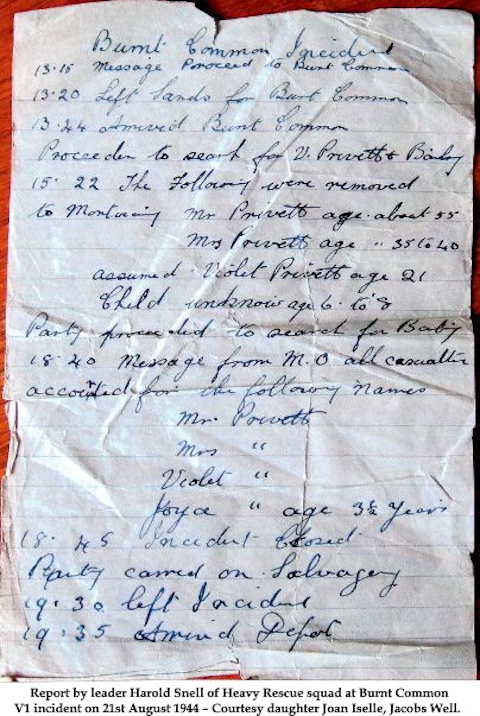 Just over a week earlier on August 12, at 11.10pm, another V1 fell not far away and struck a tree in a field alongside and to the north-east of Send Barns Lane, halfway between the A3 and Barns Corner (in the vicinity of present days Kevan Drive). One man was killed and another injured by flying glass and there was a report of eight others being slightly hurt.
Just over a week earlier on August 12, at 11.10pm, another V1 fell not far away and struck a tree in a field alongside and to the north-east of Send Barns Lane, halfway between the A3 and Barns Corner (in the vicinity of present days Kevan Drive). One man was killed and another injured by flying glass and there was a report of eight others being slightly hurt.
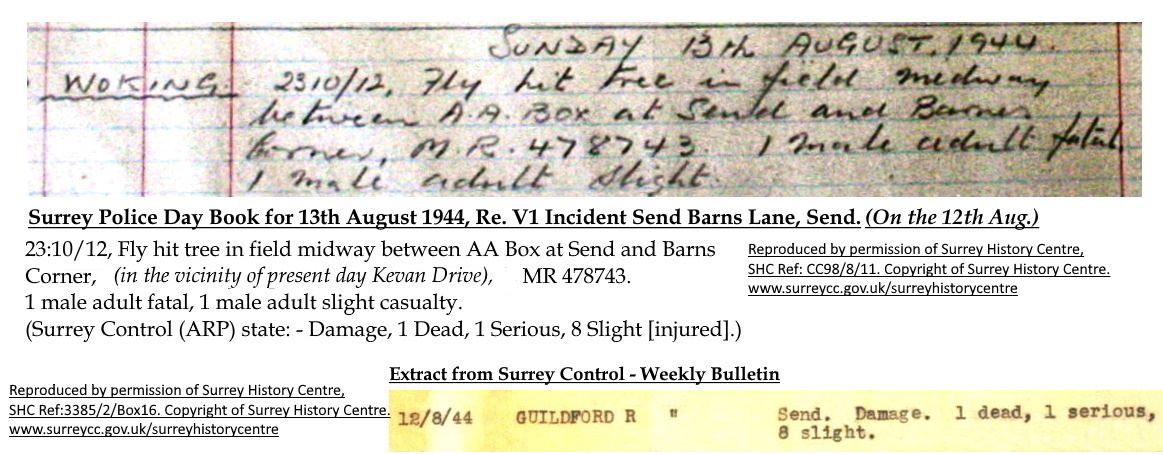
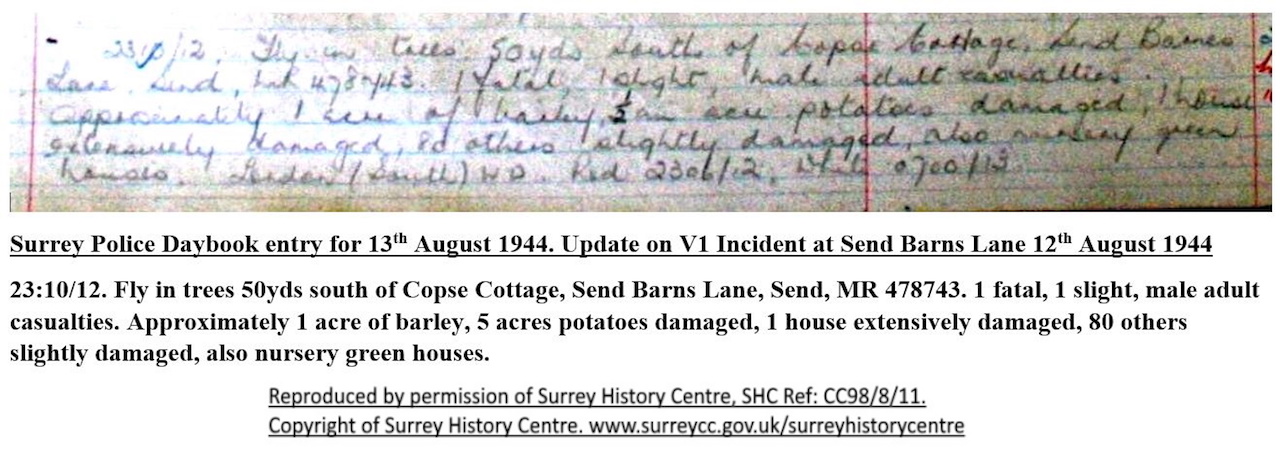 Damage was caused to approximately one acre of barley, five acres of potatoes, one house was extensively damaged and slight damage was caused to windows and ceilings of 80 other houses and to the nearby glasshouses. The wasps that had a nest in the tree that had been struck, returned shortly afterwards and “continued their normal activities” reported the Surrey Advertiser.
Damage was caused to approximately one acre of barley, five acres of potatoes, one house was extensively damaged and slight damage was caused to windows and ceilings of 80 other houses and to the nearby glasshouses. The wasps that had a nest in the tree that had been struck, returned shortly afterwards and “continued their normal activities” reported the Surrey Advertiser.
The person who was killed was 21-year-old Peter Griffiths from Swansea. He was either on holiday in the area or had been posted to Surrey in connection with his metallurgical research.
He had just visited a friend and was walking along the road at the time he was killed. Death was instantaneous but he seemed to have no visible sign of any injuries and had been killed by the effects of the explosion. Peter Griffiths served in the Home Guard and is buried in Brynteg Cemetery, Gorseinon, Swansea.
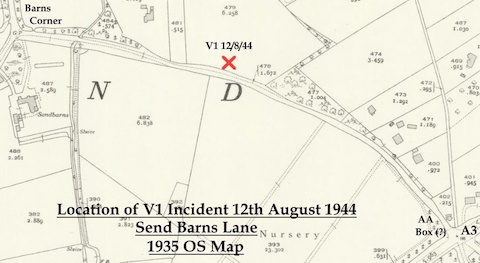 Nearly three weeks earlier still on July 23 at 7.40am, a V1 struck a tree behind the back garden of 10 Grove Heath North and exploded on impact.
Nearly three weeks earlier still on July 23 at 7.40am, a V1 struck a tree behind the back garden of 10 Grove Heath North and exploded on impact.
 There were two slight female casualties, extensive damage to one house, damage to 13 other houses and minor damage to 61 properties. In addition, half an acre of growing wheat was devastated at Grove Heath Pig Farm owned by Herbert Bedser.
There were two slight female casualties, extensive damage to one house, damage to 13 other houses and minor damage to 61 properties. In addition, half an acre of growing wheat was devastated at Grove Heath Pig Farm owned by Herbert Bedser.
 At number 10 the ceiling of a bedroom collapsed onto a child’s bed. At number 8 (Purser family) some roof tiles were lost and brickwork was cracked. The ARP services had the roof tarpaulined over and other damage repaired.
At number 10 the ceiling of a bedroom collapsed onto a child’s bed. At number 8 (Purser family) some roof tiles were lost and brickwork was cracked. The ARP services had the roof tarpaulined over and other damage repaired.
 The remains of the V1 ended up in the orchard behind 6,7 and 8 Grove Heath North and were deposited in a ditch at the far end of the orchard. It was some of these parts that John Glanfield and his brother triumphantly carried off and were stopped by the policeman and told to return them from whence they came.
The remains of the V1 ended up in the orchard behind 6,7 and 8 Grove Heath North and were deposited in a ditch at the far end of the orchard. It was some of these parts that John Glanfield and his brother triumphantly carried off and were stopped by the policeman and told to return them from whence they came.
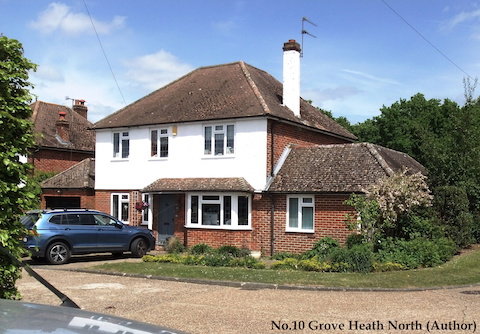 On the same day as the Burnt Common V1 incident (August 21), just before 11.30am, a V1 fell on Ripley Green 400 yards east of Dunsborough House and just north of the cricket pitch. A woman and a girl were slightly hurt and there was minor damage to approximately 100 houses.
On the same day as the Burnt Common V1 incident (August 21), just before 11.30am, a V1 fell on Ripley Green 400 yards east of Dunsborough House and just north of the cricket pitch. A woman and a girl were slightly hurt and there was minor damage to approximately 100 houses.

Other V1 incidents within Send and Ripley Parish boundaries:
5.36am, June 21, 1944: V1 in grass field at Norcon Concrete Co., Send MR 479-758. One slight male civilian casualty, one cow slightly injured owned by Mr Gribble, Papercourt Farm, Send. Structural damage etc., to farm buildings and slight damage to 24 other properties. About 60 large concrete draining pipes (earmarked by the Air Ministry in connection with a new airfield under construction) damaged.
2.07am, June 23, 1944: V1 in field at Send Hill, Send, MR 462-743. one casualty, not fatal, female adult. Damage to houses in Send Hill and shop property in Send Road. Slight fire.
Thanks go to Alan Cooper and Send & Ripley History Society for some of the information supplied for this article.
Responses to V1 Flying Bomb Attacks On Send and Ripley – Burnt Common Incident And Others
Leave a Comment Cancel reply
Please see our comments policy. All comments are moderated and may take time to appear. Full names, or at least initial and surname, must be given.Recent Articles
- Guildford MP “Frustrated” with Transport Minister Over M25 Delays
- Letter: Compton Residents Are Angry and Upset Over Tree Felling
- County Council’s ‘Devolution’ Solution ‘Will Doom’ West Surrey To Fail
- Dragon Review: Handbagged – Yvonne Arnaud Theatre
- How VE Day Was Celebrated 80 Years Ago in Guildford
- Dragon Interview: Sir Jeremy Hunt MP on His Knighthood and Some Local Issues
- Guildford Has a New Mayor with Rock Star Quality
- Ash Street Co-op Still Suffering Fallout From Cyber Attack
- Guildford’s Job Centre Among 238 Hit By Data Breaches, Say Experts
- Surrey’s Boroughs and Districts To Submit Their Three-Unitary Council Plan


Recent Comments
- Rachel Buckett on Memories Of Queen Elizabeth Barracks And The Women’s Royal Army Corps
- Brian Creese on Guildford Has a New Mayor with Rock Star Quality
- Richard Sherlock on Guildford Has a New Mayor with Rock Star Quality
- Angela Gunning on Letters, Comments, Complaints Policy and Privacy Statement
- Peter Mills on Trans Protest on Guildford High Street
- Arthur Pint on Police Investigate Paint Attack at Guildford Business Park
Search in Site
Media Gallery
Dragon Interview: Local Artist Leaves Her Mark At One of England’s Most Historic Buildings
January 21, 2023 / No Comment / Read MoreDragon Interview: Lib Dem Planning Chair: ‘Current Policy Doesn’t Work for Local People’
January 19, 2023 / No Comment / Read MoreA3 Tunnel in Guildford ‘Necessary’ for New Homes, Says Guildford’s MP
January 10, 2023 / No Comment / Read More‘Madness’ for London Road Scheme to Go Ahead Against ‘Huge Opposition’, Says SCC Leader
January 6, 2023 / No Comment / Read MoreCouncillor’s Son Starts Campaign for More Consultation on North Street Plan
December 30, 2022 / No Comment / Read MoreCounty Council Climbs Down Over London Road Works – Further ‘Engagement’ Period Announced
December 14, 2022 / No Comment / Read MoreDragon Interview: GBC Reaction to the Government’s Expected Decision to Relax Housing Targets
December 7, 2022 / No Comment / Read MoreHow Can Our Town Centre Businesses Recover? Watch the Shop Front Debate
May 18, 2020 / No Comment / Read More



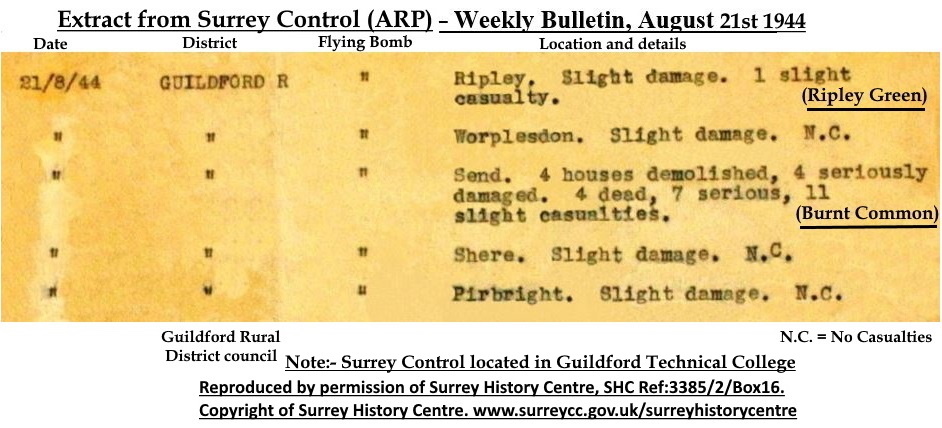







Jan Messinger
May 31, 2022 at 8:10 am
Fantastic article. Thank you.
David Harding
June 17, 2023 at 11:04 pm
Hello I’m looking for information about a V1 landing in Applegarth Claygate Surrey. Any help would be most appreciated. I’m looking for photographic evidence and news articles, dates etc. Many thanks.
Frank Phillipson
June 19, 2023 at 11:41 pm
What is the date of this V1 incident?